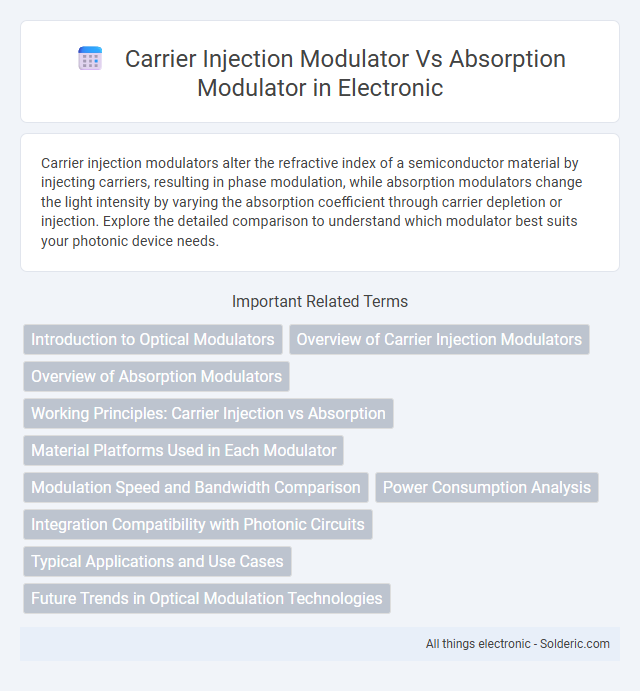Carrier injection modulators alter the refractive index of a semiconductor material by injecting carriers, resulting in phase modulation, while absorption modulators change the light intensity by varying the absorption coefficient through carrier depletion or injection. Explore the detailed comparison to understand which modulator best suits your photonic device needs.
Comparison Table
| Feature | Carrier Injection Modulator | Absorption Modulator |
|---|---|---|
| Modulation Mechanism | Injection of carriers into the active region changes refractive index | Change in absorption coefficient by electric field or carrier depletion |
| Speed | Typically slower (GHz range) due to carrier lifetime | Faster modulation speeds (tens of GHz) possible |
| Insertion Loss | Low insertion loss | Higher insertion loss due to absorption changes |
| Voltage Drive | Requires current injection (forward bias) | Reverse biased voltage or electric field applied |
| Wavelength Range | Broadband operation possible | Wavelength sensitive due to absorption edge |
| Complexity | More complex due to carrier injection and recombination | Simpler design with direct absorption control |
| Applications | Low-speed optical communication, integrated photonics | High-speed optical communication, ultrafast signal processing |
Introduction to Optical Modulators
Optical modulators control light properties to encode information in fiber-optic communication. Carrier injection modulators manipulate refractive index by electrically injecting carriers, enabling phase and intensity modulation with moderate speed and integration ease. Absorption modulators, often based on the quantum-confined Stark effect, rely on electric field-induced absorption changes for faster response and lower insertion loss, making them ideal for high-speed optical networks.
Overview of Carrier Injection Modulators
Carrier injection modulators operate by injecting carriers into the active region of a semiconductor waveguide, which alters the refractive index and absorption coefficient to modulate light signals effectively. This modulation technique offers slower response times compared to absorption modulators but enables higher modulation depths with lower power consumption. Your choice of a carrier injection modulator is ideal for applications requiring strong optical signal modulation over longer durations, such as in certain fiber optic communication systems.
Overview of Absorption Modulators
Absorption modulators control light intensity by varying carrier density in semiconductor materials, resulting in changes to the material's absorption coefficient through the Franz-Keldysh or quantum-confined Stark effects. These modulators are advantageous for high-speed optical communication due to their compact size and low driving voltage requirements. Carrier injection modulators, in contrast, modulate light by directly injecting carriers to change the refractive index, often resulting in slower response times and larger device footprints compared to absorption modulators.
Working Principles: Carrier Injection vs Absorption
Carrier injection modulators operate by injecting carriers--electrons and holes--into the waveguide, altering the refractive index and enabling phase modulation through changes in the carrier concentration. Absorption modulators function by varying light absorption in the material, typically through the quantum-confined Stark effect or carrier depletion, influencing optical intensity directly. Your choice between these modulators depends on whether phase modulation or intensity modulation suits your optical communication or signal processing needs.
Material Platforms Used in Each Modulator
Carrier injection modulators commonly use silicon-based platforms and III-V semiconductors such as gallium arsenide (GaAs) or indium phosphide (InP) for efficient charge carrier manipulation and modulation. Absorption modulators often rely on materials like indium gallium arsenide phosphide (InGaAsP) integrated on InP substrates, which enable strong electro-absorption effects suitable for high-speed data transmission. Your choice between these modulators depends on the specific material properties required for modulation speed, integration compatibility, and wavelength range.
Modulation Speed and Bandwidth Comparison
Carrier injection modulators typically exhibit slower modulation speeds due to the recombination time of injected carriers, limiting their bandwidth to a few gigahertz. In contrast, absorption modulators operate via electric field-induced changes in absorption, enabling faster response times and bandwidths exceeding tens of gigahertz. Choosing the right modulator for your application depends on the required speed and bandwidth, with absorption modulators being preferable for high-speed optical communication systems.
Power Consumption Analysis
Carrier injection modulators generally consume more power due to the need for continuous current to inject carriers into the device, leading to higher energy dissipation during operation. Absorption modulators, especially those based on the Franz-Keldysh or quantum-confined Stark effect, typically require lower driving voltages and currents, resulting in significantly reduced power consumption. Your choice between these modulators should consider the power efficiency requirements of your optical communication system to optimize overall energy performance.
Integration Compatibility with Photonic Circuits
Carrier injection modulators offer strong compatibility with silicon photonic circuits due to their carrier-based refractive index changes, enabling seamless integration with CMOS processes. Absorption modulators, primarily based on electro-absorption effects, provide compact footprints but often require specialized materials like III-V semiconductors for integration, potentially complicating photonic circuit design. Understanding these integration challenges helps you choose the optimal modulator type for scalable and efficient photonic systems.
Typical Applications and Use Cases
Carrier injection modulators are predominantly used in high-speed optical communication systems, including wavelength division multiplexing (WDM) networks and data center interconnects, where direct modulation of the refractive index enables efficient phase shifting and signal encoding. Absorption modulators find typical application in optical modulators for intensity modulation, such as in analog microwave photonics, LiDAR systems, and short-reach optical links, benefiting from rapid carrier-induced absorption changes for fast on-off switching. Both modulators are integral in photonic integrated circuits (PICs) for advanced signal processing and optical switching in telecommunication infrastructures.
Future Trends in Optical Modulation Technologies
Future trends in optical modulation technologies emphasize enhanced speed, reduced power consumption, and integration capabilities. Carrier injection modulators offer high modulation depth but face limitations in bandwidth due to carrier lifetime, prompting research into novel materials like graphene for faster response. Absorption modulators, leveraging electro-absorption effects in quantum well structures, are advancing towards higher modulation speeds and compact footprints suitable for next-generation photonic integrated circuits.
Carrier injection modulator vs absorption modulator Infographic

 solderic.com
solderic.com